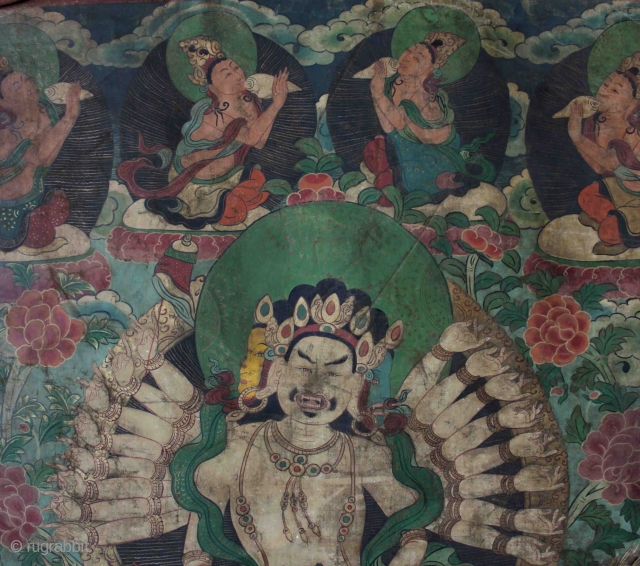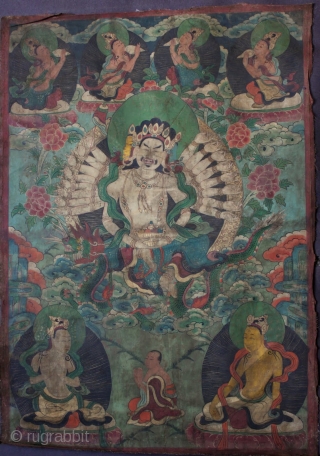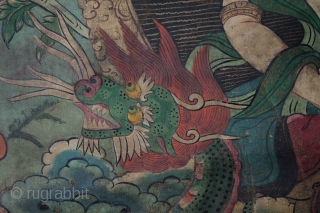For more photos and a fuller explanation of the iconography, see the link below.
Maha Cundi is a form of Avalokitesvara or Guan Yin with 18 arms, 3 faces and crown who usually holds ritual implements and has a yellow body and white robe. Maha Cundi also usually has two dragon or Naga King attendants and is said to be the manifestation of the World Honored One entering into the Samadhi of Spiritual Power of Transformation of Space and Ocean. The eighteen arms represent the eighteen uncommon qualities which can eliminate all the negative karma of sentient beings, hence the Tantric epithet 'Most Victorious or Subjugation Vajra'. The elevated arms in this thangka give a wonderful dynamic effect of movement.
Maha Cundi's mantra is: "namo saptanam samyaksambuddha kotinam. tadyatha: om! cale, cule, cundi SVAHA!" The thangka has unusual iconography as Maha Cundi normally has the first pair of hands folded in heart mudra and has one face rather than three. There is another form of Avalokisteshvara, Jambhala who is depicted seated on a green dragon. Nepalese Newari thangkas sometime contain variant iconography and the style of the painting, the dragon and flowers also remind me of some eastern Tibetan thangkas. Any comments or suggestions on its origin are welcome. See more photos here: http://kilim.ie/TRIBAL_ART_AND_ANTIQUES/Pages/Tibetan_Buddhist_and_Mongo... Please email me for more information or with any questions.
- Home
- Antique Rugs by Region
- Category
- Profiles
- Post Items Free
- Albums
- Benaki Museum of Islamic Art
- Budapest: Ottoman Carpets
- Gulbenkian Museum
- Islamic Carpets. Brooklyn
- Islamic Textiles. Brooklyn
- Konya Museum: Rugs
- MKG, Hamburg
- MMA: Caucasian Carpets
- MMA: Mamluk Carpets
- MMA: Mughal Indian Carpets
- MMA: Ottoman Carpets
- MMA: Safavid Persian Carpets
- MMA: Turkmen Rugs
- McCoy Jones Kilims
- Ottoman textiles. Met
- Philadelphia Museum
- Rugs and Carpets: Berlin
- Seljuqs at the Met
- TIEM, Istanbul: Carpets
- V&A: Classical Carpets
- Vakiflar Carpets: Istanbul
- Baluch Rugs: Indianapolis
- Gallery Exhibitions
- Jaf an Exhibition
- Alberto Levi Gallery
- Andean Textile
- Christie's London: 2016
- Francesca Galloway
- HALI at 40
- ICOC Washington, DC 2018
- Jajims of the Shahsavan
- London Islamic Week April, 2018
- Mongolian Felts
- Navajo Rugs: JB Moore
- Persian Piled Weavings
- SF Tribal & Textile Art Show 2020
- SF Tribal 2019
- Sotheby's: C. Alexander
- Turkish Prayer Rugs
- Turkmen Main Carpets ICOC 2007













